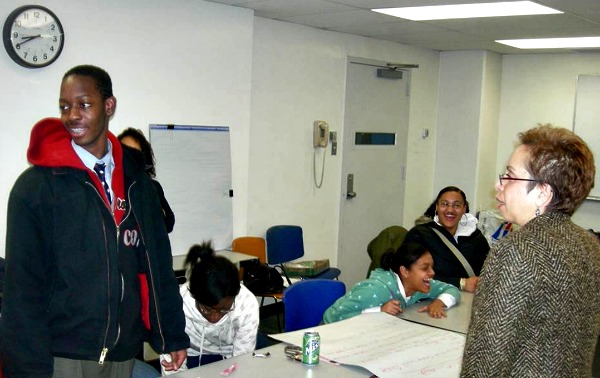
The author as a student in the EEP program at Einstein, circa 2007.
A recent publication by the Association of American Medical Colleges reports that only 4 percent of physicians in the U.S. are black, and that there were fewer black men enrolled in medical school in 2014 than in 1978. This striking and disheartening shortage holds serious consequences for all of society. Studies show that less diversity amongst physicians has major implications for healthcare disparities, and negatively affects the balance of the standard of care for people across different cultures and backgrounds. If we do not remodel our efforts of recruitment and support for students in underserved populations, the percentage of black physicians will continue to decline.
Encouraging Black Males to Become Doctors
These students have aspirations of careers in healthcare or science but often are deterred from these ambitions once faced with the reality of meager systemic social support. One organization that is combating this problem head-on is the Einstein Enrichment Program (EEP), a Science and Technology Entry Program that serves students in grades 7–12 who demonstrate high academic school performance, who are economically disadvantaged or who have been historically underrepresented in science, technology, engineering and mathematics (STEM). Being a former EEP student and current resident at Montefiore Medical Center I understand both the social disparity of becoming a doctor and the value of pipeline programs.
It is a peculiar experience to realize that aspects of your existence, whether tangible such as gender and ethnicity or intangible such as socioeconomic status, mandate certain career trajectories, each with its own identity-specific preset roadmaps. Growing up in the Bronx, I first wanted to become a doctor during early adolescence, but at that time I thought “black male doctors don’t come from here. They don’t exist.” In high school, my guidance counselor at Mount St. Michael Academy—also in the Bronx—introduced us to EEP, a program that gave underrepresented teens a chance to become doctors. As he shared this prospect he also impressed upon us that this was not a common opportunity for boys in our community.
What a Doctor Looks Like
After learning about EEP I applied and was accepted into it along with several other talented high school students from throughout New York City. That summer I shadowed Dr. Christopher Phang, a mixed-race pediatrician at Jacobi Medical Center, who was well respected by his patients and his peers. Working with Dr. Phang, and hearing similar stories of inspiration from other EEP students about mentors who look like them and have shared experiences, encouraged my decision to become a doctor. As Nilda Soto, the assistant dean for the office of diversity enhancement at Albert Einstein College of Medicine and program director of EEP, stated, “Some of these young people just don’t have those opportunities; they just don’t have the role models.”
EEP helped me make a mental shift when thinking about my aspirations. It allowed me to change, in my mind, “maybe” I could become a doctor to I “will” become one. This is a perspective that would shape my journey and allow me to accept the challenges of becoming a physician “while black.” The reality is that black professionals are, as Yale law professor Stephen Carter says, “measured by a different yardstick: first black, only black, best black.” The length of this yardstick is truncated by imposed ethnic stereotypes and social constructs that place both external and internal limits on their potential, impacting professional trajectories and personal ambitions. Programs such as EEP encourage minority students to denounce the null hypothesis or assumption that their professional capacity is dictated by their physical traits. That summer, I made the decision to be great, and I enrolled at New York University as a premedical student.
Culture Shock
There, I entered a world where many of my new peers were accustomed to an abundance of resources and endless support for the pursuit of their goals. I was now competing in a new environment. I was not immune to the intangible hardships of this process. It was a miracle that I passed general chemistry with a textbook that I was able to borrow from the library only for a few hours at a time.
Throughout this experience I often reflected on the absence of diversity within medicine, which led me to understand that despite stemming from a range of complex causes, the reason is notably simple. Many people are not becoming doctors because they don’t have the resources or support. This is largely due to the lack of diversity itself, not only in student bodies but also at the administrative level of universities where cultural knowledge of distinct student populations is not apparent.
Laying Foundations
Having goals is important, but having systems that support those goals is vital to achieving them. The purpose of pipeline programs such as EEP is to encourage the dreams of minority students not only to become doctors but also to go into other professions such as veterinary care, nursing and non-STEM careers. The impact of these programs is palpable throughout different career stages. This is demonstrated by organizations such as the Summer Medical and Dental Education Program and National Medical Fellowships, which provide support at the college and graduate medical levels respectively.
Nowadays, subtle yet deep-seated institutional racism is often eclipsed by conspicuously newsworthy individual bias. In order to increase the percentage of minority physicians we must continue to treat foundational prejudice by bolstering pipeline programs. Unless we identify and fix the instances where the system falls short, gifted students will continue to be deprived of opportunities.

